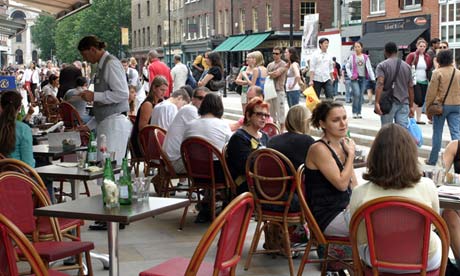Mass grave in London reveals how volcano caused global catastrophe
Scientists search for the explosive source of a disaster that wiped out almost a third of Londoners in 1258
- The Observer, Saturday 4 August 2012

When archaeologists discovered thousands of medieval skeletons in a mass burial pit in east London in the 1990s, they assumed they were 14th-century victims of the Black Death or the Great Famine of 1315-17. Now they have been astonished by a more explosive explanation – a cataclysmic volcano that had erupted a century earlier, thousands of miles away in the tropics, and wrought havoc on medieval Britons.
Scientific evidence – including radiocarbon dating of the bones and geological data from across the globe – shows for the first time that mass fatalities in the 13th century were caused by one of the largest volcanic eruptions of the past 10,000 years.
Such was the size of the eruption that its sulphurous gases would have released a stratospheric aerosol veil or dry fog that blocked out sunlight, altered atmospheric circulation patterns and cooled the Earth's surface. It caused crops to wither, bringing famine, pestilence and death.
Mass deaths required capacious burial pits, as recorded in contemporary accounts. In 1258, a monk reported: "The north wind prevailed for several months… scarcely a small rare flower or shooting germ appeared, whence the hope of harvest was uncertain... Innumerable multitudes of poor people died, and their bodies were found lying all about swollen from want… Nor did those who had homes dare to harbour the sick and dying, for fear of infection… The pestilence was immense – insufferable; it attacked the poor particularly. In London alone 15,000 of the poor perished; in England and elsewhere thousands died."
There does not seem to have been any explanation at the time; it was probably assumed to be a punishment from God. London's population at the time was around 50,000, so the loss of 15,000 would have radically changed the city.
Surprisingly, perhaps, the volcano's exact location has yet to be established. Mexico, Ecuador and Indonesia are the most likely areas, according to vulcanologists, who found evidence in ice cores from the northern hemisphere and Antarctic and within a thick layer of ash from Lake Malawi sediments. The ice core sulphate concentration shows that it was up to eight times higher than Indonesia's Krakatoa eruption of 1883, one of the most catastrophic in history.
Some 10,500 medieval skeletons were found at Spitalfields market, the site of the Augustinian priory and hospital of St Mary Spital, and the remains suggest there may have been as many as 18,000. The excavation between 1991 and 2007 by the Museum of London Archaeology (Mola) was the largest ever archaeological investigation in the capital. It was a member of that team, osteologist Don Walker, who discovered the link with a volcano. The findings will be revealed in Mola's report, to be published on Monday.
Vulcanologist Bill McGuire said: "This was the biggest eruption in historic times. It may have brought the temperatures down by 4C, a huge amount."
--
Zenguins!
Vei8-Volcanoes of the World Webcams
Roxxfoxx~~Adventures in Geology
Penguin News Today
Penguinology: The Science of Penguins
Gentoo Penguins of Gars O'Higgins Station, Antarctica
Canis lupus 101
Dances with Werewolves
Through Golden Eyes
__._,_.___
No comments:
Post a Comment